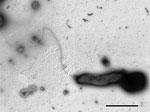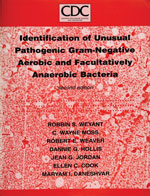Volume 29, Number 4—April 2023
Etymologia
Etymologia: Haematospirillum jordaniae
Haematospirillum jordaniae [Hae.ma.to.spi.ril′lum jor.da′ni.ae]
For the sesquipedalian term Haematospirillum, Haema is derived from the Greek haima, meaning blood. Spirillum is derived from Medieval Latin in the mid-13th century Latin (spiralis), French in the 1550s (spiral), and Greek (speira). All suggest a winding or coil. A New Latin reference book entry in 1875 implied a little coil (Figure 1).
Isolated from human blood, Haematospirillum jordaniae was reported as a novel genus and species in 2016 by Centers for Disease Control and Prevention (CDC) scientist Ben W. Humrighouse and his laboratory team, which included Jean G. Jordan, a microbiologist (Figure 2). This gram-negative bacterium was isolated 14 times in 10 states during 2003‒2012 before its identification in 2016.
H. jordaniae was previously considered an environmental bacterium with limited pathogenicity, but increasing numbers of isolates indicated a possible emerging pathogen. All cases occurred in male patients, and the pathogen showed a predilection for infecting lower leg injuries. In 2018, Hovan and Hollinger reported a case of infection in a Delaware man who, in 2016, had sepsis from a lower leg wound. The organism isolated was identified at the CDC Special Bacteriology Reference Laboratory (SBRL) in the Division of High-Consequence Pathogens and Pathology, National Center for Emerging and Zoonotic Infectious Diseases.
Jordan, who helped identify an H. jordaniae sample in 2010, was honored by having the species named after her. She spent 52 years at CDC and was one of the authors of the “The Orange Book,” the standard reference for bacterial special pathogens, more formally known as “Identification of Unusual Pathogenic Gram-Negative Aerobic and Facultatively Anaerobic Bacteria (Figure 3).” Her colleagues fondly recall Jordan, noting, “Jean was an integral part of SBRL’s founding. Although not necessarily a well-known person, she was the behind the scenes expert who never wanted any special credit.”
References
- Hovan G, Hollinger A. Clinical isolation and identification of Haematospirillum jordaniae. Emerg Infect Dis. 2018;24:1955–6. DOIPubMedGoogle Scholar
- Humrighouse BW, Emery BD, Kelly AJ, Metcalfe MG, Mbizo J, McQuiston JR. Haematospirillum jordaniae gen. nov., sp. nov., isolated from human blood samples. Antonie van Leeuwenhoek. 2016;109:493–500. DOIPubMedGoogle Scholar
- LPSN. List of prokaryotic names with standing in nomenclature. Species Haematospirillum jordaniae [cited 2022 May 21]. https://lpsn.dsmz.de/species/haematospirillum-jordaniae
- Jean Jordan obituary. Published by the Atlanta Journal-Constitution on May 28, 2014. [cited 2022 Oct 17]. https://www.legacy.com/us/obituaries/atlanta/name/jean-jordan94 obituary?id=23964116
- Pal E, Štrumbelj I, Kišek TC, Kolenc M, Pirš M, Rus KR, et al. Haematospirillum jordaniae cellulitis and bacteremia. Emerg Infect Dis. 2022;28:2116–9. DOIPubMedGoogle Scholar
- Persiana (1875) (Latin Edition): Heckmanns, Alexius. Spirillum (n.) [cited 2022 May 21]. https://www.etymoline.com/word/spirillum
- Weyant RS, Moss CW, Weaver RE. Hollis, Jordan JG, Cook E, et al.; Centers for Disease Control and Prevention. Identification of unusual pathogenic gram-negative aerobic and facultatively anaerobic bacteria. The Orange Book, 2nd ed. Philadelphia: Lippincott Williams and Wilkins; 1996.
Figures
Cite This ArticleOriginal Publication Date: March 16, 2023
Related Links
Table of Contents – Volume 29, Number 4—April 2023
| EID Search Options |
|---|
|
|
|
|
|
|



Please use the form below to submit correspondence to the authors or contact them at the following address:
Clyde Partin, Department of Internal Medicine, Emory University, 1365 Clifton Rd NE, Atlanta, GA 30322-1007, USA
Top